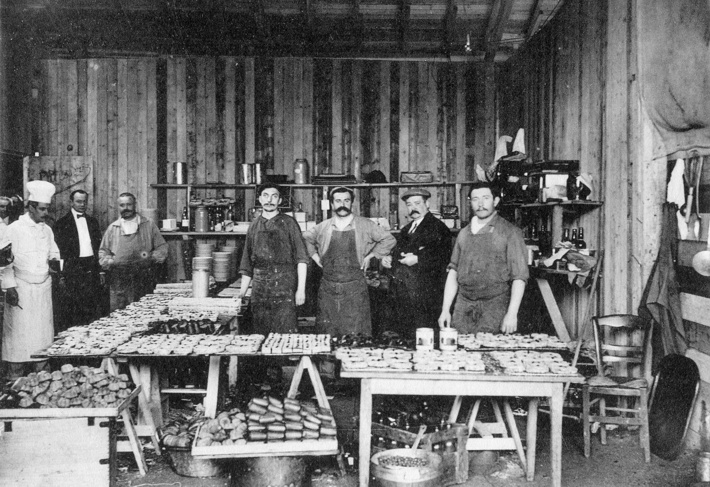Deuxième Grande Semaine d'Aviation de Champagne
Reims, France, July 3rd - 10th, 1910
Reims, France, July 3rd - 10th, 1910
The Reims/Bétheny airfield

The 1910 Reims meeting was held at the same place, but everything at the airfield had to be built from scratch again, since the temporary 1909 installations had been dismantled immediately after the meeting. The main grandstands were built in approximately the same position as the year before, only a little to the south, but everything else was changed. Just like the year before a minor temporary town was built, with shops, bars and a big restaurant.
The hangar area was enlarged and moved further to the northwest, closer to the main road. The 1909 rectangular ten-kilometre course was abandoned in favour of a five-kilometre course, which took less than half the space and was more visible to the spectators. The new course had six pylons, with two 90-degree turns and four 45-degree turns.
After the 1910 meeting the airfield was taken over by a company named "Société Anonyme Aérodrome de la Champagne", with René Hanriot as one of the managers. They built 42 new permanent hangars in place of the ones used during the meeting and bought a lot of the surrounding area, altogether 2.8 square kilometres. The airfield hosted the 1911 "Concours d'Aéroplanes Militaires" and the 1913 Gordon Bennett Trophy races.
At the outbreak of World War I the airfield was briefly used by the "Escadrille des Cigognes", until Reims fell in German hands. It took several years to repair the airfield after the war, but in 1928 it reopened as "Base Aérienne 112 Reims-Champagne" and became the home of a bomber wing. In the 1930s the base expanded rapidly. It became a test centre, from 1933 hosting a tactical evaluation unit, and also the home of a fighter wing.
By 1939 BA112 was the largest installation of the French air force, with some 300 aircraft on strength. These were dispersed over France when the "Phoney War" broke out and the RAF moved in with their Fairey Battles. In June 1940, the airfield was occupied by Germany. It was used as a maintenance and repair depot for Junkers aircraft and as a result became a popular target for Allied bombers. The Allied recaptured the airfield in August 1944 and used it as a fuel depot before it was turned over to a 9th Air Force P-47 Fighter Group. In February 1945 Reims became the headquarters for General Eisenhower, Commander of the Allied Forces in Europe. On May 7th, 1945 General Alfred Jodl signed the unconditional surrender of the Third Reich at the airfield.
After the war, it became a storage depot for surplus aircraft. The air base was reactivated in the end of the 1940s, and during the following years it was the busy home of Vampires, F-84s, F-100s, Vautours, Noratlases and Mirage F1s. In July 2008 it was announced that the base would be closed. The closing ceremony was held on June 30th, 2011 and the base was finally closed in June 2012. The airfield is now abandoned, but served as venue for the "Teknival" music festival a couple of times until 2014.

The map that was given to the officials at the 1910
meeting. North is at nine o'clock.
Click here for a big high-resolution
version!
here for a big high-resolution
version!
Click
 here for a big high-resolution
version!
here for a big high-resolution
version!

A detail map from the program of the 1910 meeting,
showing the hangars, tribunes and other installations.
Like above, north is at nine o'clock.
Click here for a high-resolution version!
here for a high-resolution version!
Click
 here for a high-resolution version!
here for a high-resolution version!

A map from the program of the 1910 meeting, showing the
position of the airfield north of Reims and its access
roads.

Not a great photo, but it shows the world's first
race-horse start, with the main grandstands in the
background. From left to right Louis Wagner's
Hanriot, Otto Lindpaintner's Sommer and Marcel
Hanriot's Hanriot. In 1910 there were two raised
pavillions, both in the middle of the grandstands. In
1909 there was only one, at the end of the biggest
grandstand. (1)

Looking southwards towards the main entrance, with a
barber shop and a flower shop, from the north end of
the main grandstand. The skyline of Reims, with its big
cathedral, can be seen on the horizon. (2)

The huge results board behind the grandstands - in fact
less than three quarters of it! There was one line for
each event and one column for each machine. (2)

The smaller of the two main grandstands, which
contained a buffet restaurant and a reserved restaurant
in the raised pavillion. (2)

The timers' pavillion, which was located inside the
course at the start/finish line. (2)

A panorama over the hangar area, with one of Walther de
Mumm's Antoinettes in the foreground. There were 61
temporary hangars, and the hangar area also contained a
restaurant. (3)

The personnel in the kitchen of the restaurant, which
was operated by M. Borgo from Paris. (2)
Too see more details, open the map in Google Maps by
clicking the "full screen" symbol at the top
right of the menu bar!
 Back to the top of
the page
Back to the top of
the page
